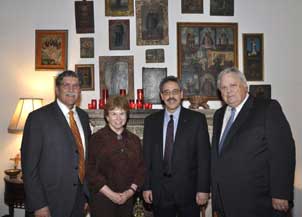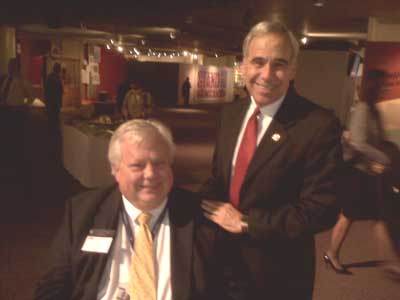As we closed out 2009, it’s nice to see some bright spots ringing in the New Year! We’d like to acknowledge the following Affiliates for their hard work and success.
Smithsonian Affiliations received $8,000 from the Smithsonian Latino Center to support research trips for the curatorial staff of the Museo de Arte de Puerto Rico (San Juan, Puerto Rico), with the goal of organizing future exhibitions featuring Smithsonian artifacts.
The North Carolina Humanities Council has awarded $7,500 to the North Carolina Museum of History (Raleigh, North Carolina) for an expansion of the exhibition “Standing on a Box: Lewis Hine’s National Child Labor Committee Photography in North Carolina.” In addition, State Employees’ Credit Union Foundation has provided $500,000 to benefit the museum’s new SECU Education Center. The museum has also received a 2009 Creative Award from the North Carolina Museums Council for its Bits of History podcast series.
Museum of Arts and Sciences (Macon, Georgia) received a $10,000 grant from College Hill Corridor to hold “Art of the Hill” a spring break day camp.
North Carolina Museum of Natural Sciences (Raleigh, North Carolina), is the recipient of a $4 million grant from the State Employees Credit Union Foundation to support the Museum’s SECU Daily Planet centerpiece of the planned Nature Research Center.
Through state grants and local donations The Hermitage (Nashville, Tennessee) will begin a $1 million facelift to repair weather damage and wear and tear.
The Challenger Space Center (Peoria, Arizona) was awarded $50,000 from the Tohono O’odham Nation in September 2009 for a grant which will be primarily used for two new exhibits, the Gemini 8 and PlayMotion. The grant money will also help bring objects from the Smithsonian to the center for the Gemini 8 exhibit.
National Mississippi River Museum and Aquarium (Dubuque, Iowa) received a $500,000 earmark for exhibit fabrication and installation as part of the FY 2010 Labor, Health and Human Services Appropriations bill. The museum also has received a $1.23 million grant from Iowa River Enhancement Community Attraction & Tourism program to complete an outdoor plaza for their new museum expansion project.
Michigan State University Museum (East Lansing, Michigan) received a $40,000 grant from the National Endowment for the Arts to support the Great Lakes Folk Festival.
Joe B. Keiper has been named Executive Director of the Virginia Museum of Natural History (Martinsville, Virginia).
Mid-America Science Museum (Hot Springs, Arkansas) was awarded $286,036 from the Donald W. Reynolds Foundation to fund a two year planning process aimed at improving the museum’s operations and exhibits.
Smithsonian Institution Traveling Exhibition Services recently announced the latest recipients of their Smithsonian Community Grant program, supported by MetLife Foundation including two Affiliates:
- Birmingham Civil Rights Institute (Birmingham, Alabama) was awarded $4,500 to develop a teacher workshop, guest speaker, and advertising and promotion of programming related to the themes of 381 Days: The Montgomery Bus Boycott Story.
- The Women’s Museum: An Institute for the Future (Dallas, Texas) received $4,600 to fund a visit from Queen Nur, and create a gallery guide insert and marketing materials for events related to the themes of Freedom’s Sisters.
Three Smithsonian Affiliates were recipients of MetLife Foundation’s Museum and Community Connections program grants. The grants were awarded to 15 museums for exhibitions, artist residencies, and other programs that extend their reach into diverse communities.
- Buffalo Bill Historical Center (Cody, Wyoming) ($70,000)
For the Splendid Heritage: Perspectives on Native American Art exhibit and accompanying family days, lecture series, and artist residencies.
- Japanese American National Museum (Los Angeles, California) ($50,000)
For Mixed: Portraits of Multiracial Kids exhibit featuring portraits, hand-drawn statements, and stories of multiracial children in the United States.
- Wing Luke Asian Museum (Seattle, Washington) ($50,000)
For the Asian Pacific Islander American Art Making: Explorations in Identity and Community initiative, which includes exhibits and corresponding public programs and workshops.




 This question has been on my mind since visiting the Institute of Texan Cultures to announce our new affiliation on January 28, 2010. Housed in the formidable Texas Pavilion, a landmark of San Antonio’s HemisFair Park, the Institute celebrates the diverse heritage of early Texans in its core exhibition, Texans One and All. Here one finds thoughtfully interpreted and artifact-filled displays of Mexican, African American, Czech, German, Jewish, and Lebanese Texans, among others, and…. Wends.
This question has been on my mind since visiting the Institute of Texan Cultures to announce our new affiliation on January 28, 2010. Housed in the formidable Texas Pavilion, a landmark of San Antonio’s HemisFair Park, the Institute celebrates the diverse heritage of early Texans in its core exhibition, Texans One and All. Here one finds thoughtfully interpreted and artifact-filled displays of Mexican, African American, Czech, German, Jewish, and Lebanese Texans, among others, and…. Wends.






 Museum of Latin American Art (Long Beach, CA)
Museum of Latin American Art (Long Beach, CA)



